Acupoints for Cancer Patients
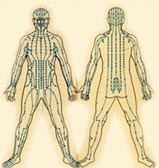 |
| Meridians are a collection of acupoints. |
According to TCM theory, our body has a giant web called the meridian system linking different parts together; its pathways make up a comprehensive yet complex body map that supplies qi (vital energy) to every part of the body. Along these pathways, acupoints are the sites through which the qi of the organs and meridians is transported to the body surface. Acupuncturists work on these special points to regulate corresponding organs or meridians so that the body can return to a state of balance and health.
It is well recognized that acupuncture helps in the treatment of cancer or treatment-related symptoms. Acupuncture is suitable for all stages of cancer especially for patients who have low immunity. Some of the indications include pain, fever, abdominal distention, nausea, breathlessness, urinary difficulty, insomnia and limbs puffiness.
This treatment modality relies on sophisticated skills to select appropriate acu-points, to insert needles accurately and to manipulate stimulation techniques such as twirling, flicking, lifting, and thrusting as well as applying heat or a weak electrical current to enhance the effects. Application procedures vary according to physician.
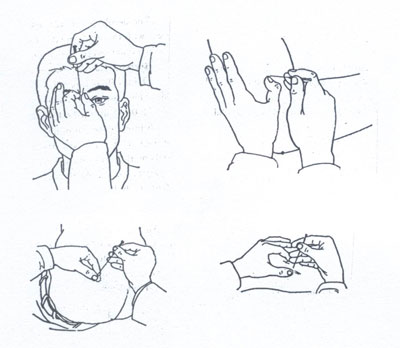 |
| Different ways of needle insertions. |
Generally, stimulation techniques are divided into three categories:
|
Reinforcing techniques are adopted to invigorate the body's resistance and boost the under-functioning of the body. Needling techniques are generally slow, gentle and of short duration. |
|
Reducing techniques are adopted to eliminate pathogens and suppress the hyper-functioning of the body. Needling techniques are generally rapid, forceful and of long duration. |
|
Even techniques are adopted when there is no particular reason to use the above techniques. |
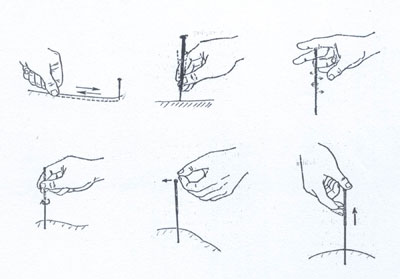 |
| Different ways of stimulation techniques. |
The following are acupoints recommended by one famous TCM physician. They help to improve the overall condition of the individual.
Cancer Types |
Major Acu-points |
| Esophagus cancer |
Tian-ding, ju-que, shang-wan, zhong-wan, nei-guan, zu-san-li, jue-yin-shu, ge-shu, pi-shu, he-gu |
| Stomach cancer |
Ju-que, shang-wan, zhong-wan, ri-yue, tian-shu, qi-hai, zu-san-li, nei-guan |
| Liver cancer |
Gan-shu, nei-guan, gong-sun, xing-jian, yang-ling-quan |
| Lung cancer |
Fei-shu, zhong-fu, tai-yuan, feng-men, xin-shu, tian-zong, gao-huang, chi-ze, tan-zhong |
| Abdominal cancer |
Zhang-men, pi-gen, zu-san-li, qi-hai, tian-shu, shui-dao, shang-wan, shui-fen |
| Ovarian cancer |
Guan-yuan, zhong-ji, shui-dao, gui-lai, shen-shu, san-jiao-shu, san-yin-jiao, zu-san-li |
| Colorectal cancer |
Shang-wan, zhong-wan, xia-wan, ri-yue, tian-shu, da-heng, qi-hai, guan-yuan, pi-shu, wei-shu, da-chang-shu, cheng-shan, shang-ju-xu, qu-chi |
| Breast cancer |
Jian-jing, ying-chuang, ru-gen, tan-zhong, shang-wan, da-zhui, xin-shu, pi-shu, ge-shu, jian-zhen, san-yin-jiao |
| Cervical cancer |
Qi-hai, zhong-ji, da-ju, shui-dao, gui-lai, shen-shu, bai-liao, san-yin-jiao |
| Skin cancer |
Fei-shu, tai-yuan, pi-shu, da-du, jie-xi, yang-ling-quan, zu-san-li, feng-long, wei-zhong, yin-ling-quan |
| Nasopharyngeal cancer |
Feng-chi, xia-guan, ting-gong, zan-zhu, shang-xing, bai-hui, he-gu |
In addition to selecting acupoints according to cancer type, physicians also select particular acupoints for the relief of symptoms.
Symptoms |
Acupoints |
| Headache in |
 |
crown |
 |
forehead |
 |
lateral |
 |
posterior region |
|
| |
| Bai-hui, tong-tian, xing-jian |
| Shang-xing, tou-wei, he-gu |
| Shuai-gu, tai-yang, xia-xi |
| Hou-ding, tian-zhu, kun-lun |
|
| Ribside pain |
Qi-men, zhi-gou, zu-san-li, yang-ling-quan, tai-chong, xing-jian, qiu-xu |
| Stabbing pain in breasts |
Tai-yuan, lie-que |
| Breast tenderness |
Shao-ze, tai-yang |
| Gastric pain |
Zhong-wan, qi-men, zu-san-li, wei-shu, pi-shu |
| Abdominal pain |
Zhong-wan, shen-que, guan-yuan, gong-sun, zu-san-li |
| Abdominal distention |
Pi-shu, zu-san-li, qi-hai |
| Nausea and vomiting |
Ge-shu, nei-guan, pi-shu |
| Poor appetite |
Zu-san-li, wei-shu, zhong-wan, nei-guan, tai-bai |
| Indigestion |
Zu-san-li, pi-shu, gong-sun, tian-shu |
| Dysphasia |
Pi-shu, zu-san-li |
| Diarrhea |
Tian-shu, shang-ju-xu, yin-ling-quan, zhong-wan, pi-shu, zhang-men |
| Abdominal gurgling |
Xia-wan, xian-gu |
| Constipation |
Zhi-gou, cheng-shan, tai-xi; zhang-men, tai-bai, zhao-hai; tian-shu, shi-men, xia-ju-xu; da-chang-shu, xiao-chang-shu, zu-san-li |
| Urinary difficulty |
Guan-yuan, san-yin-jiao, zhong-ji |
| Dizziness |
Qi-hai, bai-hui, feng-chi, xing-jian, qu-chi, tai-chong |
| Insomnia |
Xin-shu, bai-hui, shang-xing, jian-shi |
| Palpitation |
Xi-men, shen-men, xin-shu, ju-que |
| Coughing |
Qu-chi, fei-shu |
| Excessive throat secretion |
Qu-chi, da-zhui, tian-tu |
| Sore throat |
Shao-shang, che-ze |
| Low fever |
Da-zhui, qu-chi, he-gu, shao-shang |
| Night sweating |
Tai-xi, yin-xi, fu-liu, |
| Mouth dryness |
Shang-lian-quan, he-gu, zu-san-li |
| Convulsion |
Yin-tang, bai-hui, da-zhui, he-gu |
Moxibustion Therapies
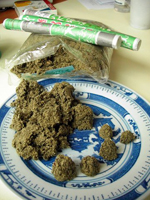 |
| Loose moxa is molded in different shapes for application. |
Moxibustion can accompany acupuncture in a direct or indirect way. Physicians lit moxa (a dry herb of mugwort) over specific acupoints to provide penetrating heat to activate qi and blood flows in the meridians. Mugwort itself can also dispel cold, relieve pain and arrest bleeding; therefore, it is indicated for relevant TCM syndromes. |
| |
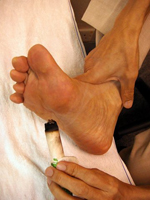 |
| Warming with a moxa stick on yung-quan. |
For cancer patients, moxibustion alone can usually be applied on symptoms such as pain, vomiting, coughing and abdominal discomforts that caused by cold or dampness accumulation as well as sluggish flow in certain regions. For example, if patients experience excessive sweating in the head or persistent coughing, it is helpful to warming with moxa sticks on yung-quan (an acupoint on the soles), the technique can invigorate kidney's qi grasping function. It is also said that warming with moxa sticks on certain acupoints could enhance immune functions and promote blood cells production in cancer patients. |
| |
There are contraindications for acupuncture and moxibustion. Moxibustion is not appropriate for high and persistent feverish conditions, while patients with skin rashes, bleeding tendency or severe swelling are not suitable for acupuncture. The two methods should not be applied on areas of inflammation, the face or locations of major vessels.
|